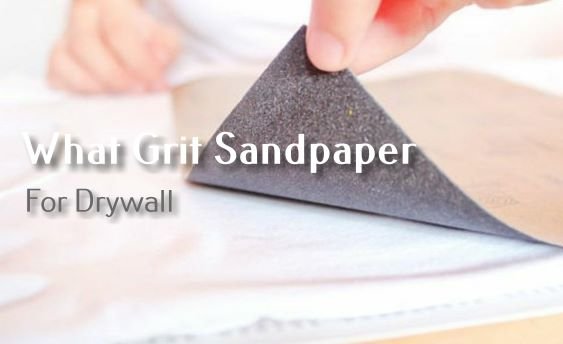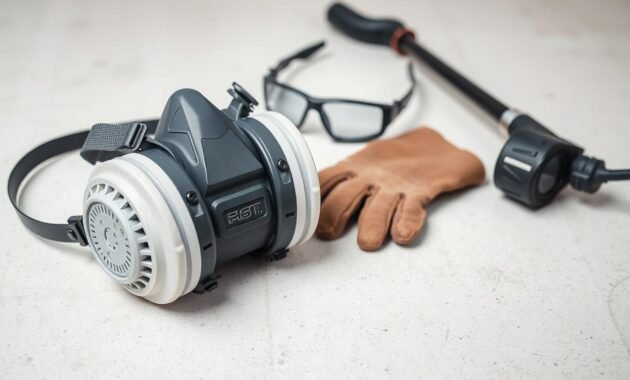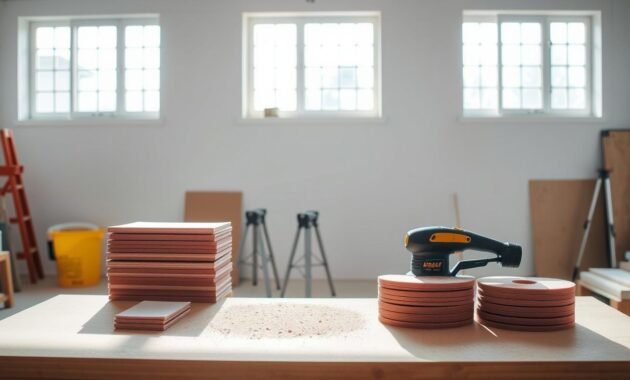Are you tired of uneven walls after a drywall project? Many DIY fans face this problem. The wrong sandpaper can make your walls look bumpy and uneven.
Finding the right grit sandpaper for drywall is key. My guide will help you pick the best sandpaper for your project. You’ll learn how to choose the perfect grit size for each step.
Whether it’s a small fix or a big wall redo, knowing the right sandpaper makes a big difference. Let’s explore how to get smooth, professional-looking walls!

Understanding Sandpaper Basics for Drywall Projects
Choosing the right sandpaper is key for a professional finish on drywall. Sandpaper might seem simple, but it’s vital for your project’s success.
Let’s dive into the basics of sandpaper. It’s important for both DIY fans and pros. The world of sandpaper for drywall can be complex, but I’ll guide you through it.
Types of Sandpaper Available
There are many types of sandpaper for drywall work:
- Traditional sandpaper sheets
- Sanding sponges
- Power sander discs
- Mesh sanding screens
- Self-adhesive sanding pads
The Importance of Grit Selection
Choosing the right grit is key for smooth surfaces. Coarse grits remove material fast, while fine grits polish. Your choice depends on your project’s stage.
How Grit Numbers Work
Grit numbers show the size of the abrasive particles. Lower numbers mean larger, more aggressive particles. Higher numbers mean smaller, smoother particles. The Coated Abrasive Manufacturers Institute (CAMI) sets these standards.
| Grit Range | Drywall Application |
|---|---|
| 40-80 | Rough material removal |
| 100-150 | Initial smoothing |
| 180-220 | Final finishing |
Knowing these basics will help you pick the right sandpaper. This ensures a professional finish every time.
What Grit Sandpaper For Drywall: Complete Guide
Choosing the right grit sandpaper for drywall is key to a successful home improvement project. Knowing what grit to use for sanding drywall is essential for a smooth finish. Different stages of drywall work need specific grits for the best results.
Read also: What Grit Sandpaper for Drywall?
When picking what grit sandpaper for drywall repair, remember a few important things. The grit number affects how smooth your surface will be and how fast you can remove material. Lower grits are coarser, while higher ones are finer.
- 150-180 grit: Ideal for most standard drywall finishing
- 100-120 grit: Best for initial rough smoothing
- 220 grit: Perfect for final, ultra-smooth finish
Experts often suggest a multi-step process. Begin with a coarser grit to remove big imperfections. Then, move to finer grits for a flawless finish. This method prevents scratches and damage to the drywall.
I always recommend having multiple grit sandpapers ready. Each project might need a different approach. Having various grits lets you adjust to different drywall conditions and repair needs.
Manual vs Power Sanding: Choosing the Right Grit
When you’re working on a drywall project, picking the right sanding method is key. Knowing the difference between manual and power sanding can help you get a top-notch finish.
Different drywall projects need different approaches. Choosing the right grit sandpaper for your patch work is important for smooth results.
Manual Sanding Grit Recommendations
Manual sanding gives you more control and precision for small patches. For most tasks, I suggest:
- First pass: 100-120 grit sandpaper
- Intermediate passes: 150 grit
- Final smoothing: 220 grit
Power Sanding Grit Guidelines
Power sanders can make your drywall project faster, but you need to pick the right grit to avoid damage:
- Initial sanding: 150 grit
- Finishing passes: 180-220 grit
- Avoid using coarse grits too aggressively
Tools and Techniques for Each Method
For manual sanding, use sanding blocks or hand sanders. With power sanders, go for orbital or random orbital sanders for better results. Always wear protective gear and work in well-ventilated areas.
Manual sanding is great for small patches, while power sanding is better for bigger areas. Choose your method based on your project’s needs.
Wet vs Dry Sanding Methods for Drywall
Choosing between wet and dry sanding can greatly affect your drywall project. I’ll explain the main differences to help you pick the right method for your needs.
Dry sanding is the traditional choice for many drywall tasks. It uses standard sandpaper and removes material quickly. But, it creates a lot of dust. When sanding drywall before painting, you need protective gear and must clean up well.
- Ideal for large surface areas
- Requires dust masks and eye protection
- Works best with power sanders
Wet sanding is a cleaner option for drywall. It uses a damp sponge to cut down dust and smooth surfaces. This method is great for tight spots and corners, where regular sanders can’t reach.
| Sanding Method | Dust Control | Best For |
|---|---|---|
| Dry Sanding | High Dust | Large Open Surfaces |
| Wet Sanding | Minimal Dust | Corners and Detailed Areas |
For sandpaper grit before painting, start with 120-150 grit for smoothing. Then, use 220 grit for the final touch. Wet sanding uses softer sponges, which are gentler on the surface. It’s ideal for the final touches.
Best Grit Ranges for Different Drywall Tasks
Choosing the right sandpaper grit is key for a top-notch drywall finish. Each step of your project needs a specific grit range for smooth results. Knowing what grit sandpaper for drywall mud and spackle helps you complete tasks confidently.
Not all sandpaper is the same when working with drywall. The grit you pick can greatly affect your project’s look.
First Coat Sanding: 120-150 Grit
For the first sanding of joint compound, use 120-150 grit sandpaper. This is the best grit for drywall mud. It gets rid of extra compound without scratching the surface, making it ready for more coats.
- Removes excess joint compound effectively
- Prevents deep scratches on the surface
- Prepares the wall for additional coats
Final Coat Finishing: 150-220 Grit
For the final stages, switch to 150-220 grit sandpaper. This finer grit is perfect for drywall spackle. It smooths out small flaws and gets the wall ready for paint.
Patch Work and Repairs: 100-180 Grit
Fixing drywall needs some flexibility. Depending on the damage, use 100-180 grit sandpaper. For big repairs, you might need coarser grits. But for small fixes, finer grits work best.
Read also: How Many Coats of Primer You Need before Painting Drywall
Pro tip: Always start with a coarser grit and then move to finer ones for the best results.
Essential Safety Equipment for Drywall Sanding
When you start a drywall project, safety comes first. Sanding drywall isn’t just about getting a smooth finish. It’s also about keeping yourself safe from health risks.

Drywall dust might seem harmless, but it’s not. It has mineral particles that can harm you if you breathe them in or get them in your eyes. Before you begin sanding, make sure you have the right protective gear.
- Safety Goggles: Protect your eyes from fine dust particles
- Respirator or Dust Mask: Essential for preventing respiratory issues
- Disposable Coveralls: Keep dust off your clothing
- Work Gloves: Protect your hands during the drywall project
Good ventilation is key when sanding. Always work in a room with plenty of air. If you can, use a dust collection system. Open windows, use fans to blow dust outside, and set up a plastic sheet to keep dust in.
No matter the grit sandpaper, protecting yourself from dust is a must. Cheap safety gear is cheaper than medical bills for dust-related health problems.
Common Mistakes to Avoid When Selecting Sandpaper Grit
Choosing the right grit sandpaper for drywall work can be tricky. Both professional painters and DIY enthusiasts often make mistakes. These mistakes can ruin the final finish of a project. Knowing these common errors can help you achieve a smoother, more professional look.
When working on drywall, picking the right sandpaper grit is key. I’ve seen many projects fail because of the wrong grit choice. Let’s look at the most common mistakes to avoid.
Dangers of Using Too Coarse Grit
Using too coarse sandpaper can damage your drywall surface. Grits below 80 can:
- Create deep, visible scratches
- Remove too much joint compound
- Require extensive repair work
- Compromise the smooth finish of your drywall
Risks of Skipping Grit Levels
Skipping grit levels is another big mistake. Professional sanders know the importance of sanding in steps.
| Mistake | Consequences | Recommended Solution |
|---|---|---|
| Jumping from 60 to 220 grit | Uneven surface, visible imperfections | Use intermediate grits (100, 150) |
| Not progressing gradually | Rough texture, additional repair needed | Follow sequential grit progression |
For successful drywall work, follow grit levels step by step. Start with coarser grits for initial smoothing. Then, move to finer grits for a polished finish. This method ensures a professional look with minimal damage.
Professional Tips for Achieving Smooth Drywall Finish
Professional drywall finishers know the secret to a flawless surface. They master “going through the grits”. This means using a progressive approach to turn rough surfaces into silky smooth walls.
I’ll share my top strategies for a perfect drywall finish. Start with coarser grit sandpaper and move to finer grits gradually. This method refines the surface without deep scratches or uneven textures.
- Begin with 120-grit sandpaper for initial rough spots
- Transition to 150-grit for smoothing intermediate layers
- Finish with 220-grit for what grit sandpaper for drywall finish perfection
When sanding, use light pressure and circular motions. Focus on corners and seams, which need extra care. A work light helps spot imperfections by casting shadows.
Pro tip: Always wear a dust mask and safety glasses. Drywall sanding creates a lot of dust. Protecting yourself is key. Check your work under different lights to ensure a smooth finish.
Remember, patience is key. Rushing the process leads to more work fixing mistakes. Take your time, go through grits systematically, and you’ll get professional-quality results every time.
Tools and Accessories for Better Sanding Results
When you’re working on a drywall project, the right tools are key. Quality accessories can make a big difference. They help you get a smooth, professional finish.
- Sanding Blocks: Provide even pressure and consistent results
- Pole Sanders: Reach high walls and ceilings with ease
- Dust Collection Systems: Keep your workspace clean
- Electric Drywall Sanders: Speed up large project completion
A sanding block is a must-have for any drywall project. It ensures even pressure, avoiding uneven surfaces. For small repairs, a manual block is great. But for bigger jobs, a power sander with dust collection is better.
Think about your project size and repair needs when choosing accessories. Light, ergonomic tools help prevent fatigue. Always match your tools with the right grit sandpaper for the best results.
- Small Repairs: Hand sanding block
- Medium Projects: Pole sander
- Large Areas: Electric drywall sander
Choosing the right tools makes your drywall project easier, faster, and more professional.
Preparing Your Space for Drywall Sanding
Starting drywall work? Get ready for a clean project. Protecting your space from dust is key. It saves you from hours of cleaning and keeps your home safe.

Before sanding, take important steps to keep your area clean. Dust control is vital, more so when you’re getting ready to paint.
- Cover all floors with heavy-duty drop cloths or plastic sheeting
- Remove or completely cover furniture in the work area
- Seal doorways and air vents with plastic sheeting
- Use painter’s tape to secure protective coverings
Choosing the right sandpaper is important. Make sure your space is ready. Dust can spread fast and ruin other areas if not stopped.
| Preparation Area | Protection Method |
|---|---|
| Floors | Heavy-duty drop cloths |
| Furniture | Plastic sheeting cover |
| Electronics | Complete removal or sealed cover |
| Air Vents | Plastic seal with painter’s tape |
Wear protective gear like a dust mask and safety glasses. Use a shop vacuum with a HEPA filter to clean up less. Your prep work affects your drywall’s finish.
Conclusion
Choosing the right grit sandpaper for drywall is key to a successful home renovation or repair. I’ve shown you the essential techniques for a smooth finish. It’s all about knowing how to use different grit levels and when to switch.
This guide has helped you pick the right sandpaper for each step of your project. From rough sanding to the final touch, the right method saves time and prevents damage. Always remember, patience and skill are more important than force when working on drywall.
Don’t let your drywall project scare you. With what you’ve learned, you can sand like a pro. Start with coarse grits for the rough work, then move to finer grits for a smooth finish. The more you practice, the better you’ll get.
Apply these techniques to your next home improvement project. Whether it’s a small fix or a big renovation, the right sandpaper and method will give you amazing results. Your work will look clean, smooth, and professional.


